Objective 3. Set Tab Stops
Tab stops mark specific locations on a line of text and are used to indent and align text. By pressing the  key, you move to tab stops.
key, you move to tab stops.
Activity 3.9. Setting Tab Stops
|
1. |
Start Word. Then, take a moment to study the tab alignment options shown in Figure 3.26 and described in the table in Figure 3.27. Figure 3.26. 
|
||||||||||||||||||||||||
|
|
|||||||||||||||||||||||||
|
2. |
From the student files that accompany this text, locate and open w03B_Park_Changes. Display the Save As dialog box. Navigate to the folder where you are storing your projects for this chapter, and then save the file as 3B_Park_Changes_Firstname_Lastname |
||||||||||||||||||||||||
|
3. |
In the paragraph beginning The hours of operation, position the insertion point after the colon at the end of the paragraph. Press Figure 3.28. 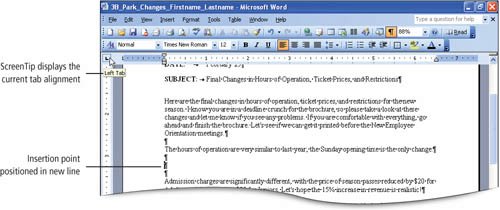
|
||||||||||||||||||||||||
|
4. |
Click the Tab Alignment button |
||||||||||||||||||||||||
|
|
|||||||||||||||||||||||||
|
5. |
Move the pointer over the horizontal ruler, click at the 1-inch mark, and then compare your screen with Figure 3.29. Figure 3.29. 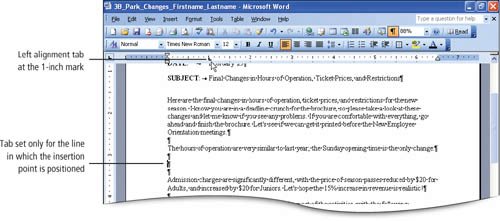
A left tab stop is inserted in the ruler. Left tab stops are used when you want the information to align on the left. By default, tab stops are set every half inch, but they do not display on the ruler. When you customize a tab as you did here, the custom tab stop overrides default tab stops that are to the left of the custom tab. |
||||||||||||||||||||||||
|
6. |
Click the Tab Alignment button |
||||||||||||||||||||||||
|
7. |
Click the Tab Alignment button Figure 3.30. 
Two center tab stops are inserted in the ruler. Center tab stops are used when you want to center information over a particular point. |
||||||||||||||||||||||||
|
8. |
Save |
Activity 3.10. Formatting and Removing Tab Stops
As you work with tab stops, keep in mind that they are a form of paragraph formatting, and thus, the information about them is stored in the paragraph mark to which they were applied.
|
1. |
From the Format menu, click Tabs, and then compare your screen with Figure 3.31. Figure 3.31. (This item is displayed on page 433 in the print version) 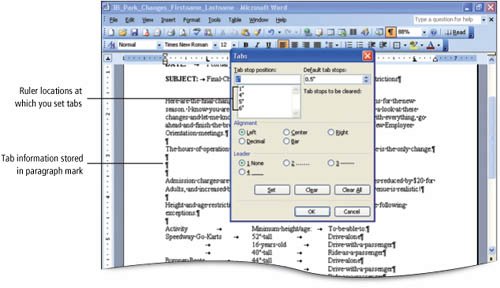
The Tabs dialog box displays. The tabs you just added to the ruler for the paragraph at the insertion point location display under Tab stop position. From the Tabs dialog box, you have more flexibility in adding, removing, and formatting tab stops. |
|
|
|
|
2. |
Under Tab stop position, click 4", and then at the bottom of the Tabs dialog box, click the Clear button. Compare your screen with Figure 3.32. Figure 3.32. 
|
|
|
|
|
3. |
Under Tab stop position, click 5". Under Leader, click the 2 option button. Near the bottom of the Tabs dialog box, click Set. |
|
4. |
Under Tab stop position, click 6". Under Alignment, click the Right option button. Near the bottom of the Tabs dialog box, click Set. Repeat this process to change the tab stop at 5" to a Right aligned tab stop as shown in Figure 3.33. Figure 3.33. 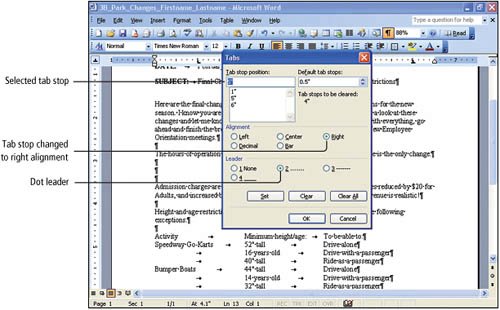
The tab stop at the 6-inch mark will be right aligned when the dialog box is closed, and the tab stop at the 5-inch mark will be right aligned with a dot leader. |
|
5. |
At the bottom of the Tabs dialog box, click OK, and notice that the changes are reflected in the ruler. Compare your screen with Figure 3.34. Figure 3.34. 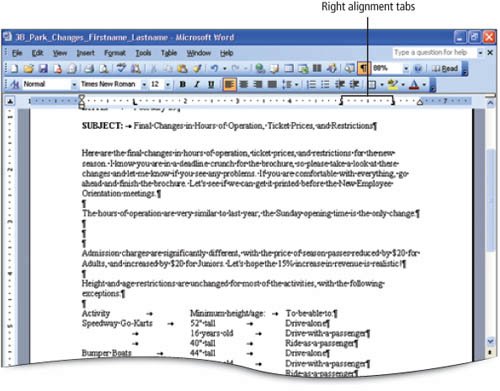
|
|
6. |
Scroll to the top of the document, and then Save |
Activity 3.11. Using Tab Stops to Enter Text
|
1. |
With the insertion point positioned at the beginning of the line with the new tab stops, press Figure 3.35. 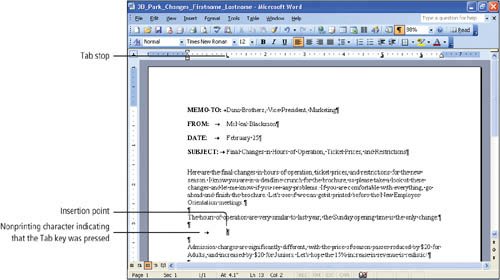
The insertion point moves to the first tab stop, which is at the 1-inch mark, and the nonprinting character for a taba small arrowdisplays. |
|||||||||
|
2. |
Type Monday-Thursday and notice that the left edge of the text remains aligned with the tab stop. Press Figure 3.36. 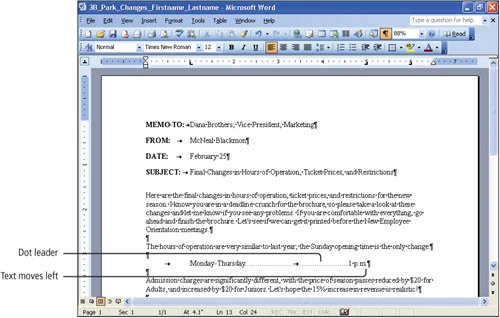
NoteUsing Dot Leaders A String of Periods Is Not the Same Thing It is sometimes tempting to hold down the Period key on the keyboard to create a string of dots. This is not a good idea for several reasons. The periods, because of proportional spacing, may be spaced differently between rows. The periods will not line up, and, most importantly, the column on the right side of the string of periods may look lined up, but will be crooked when printed. If you need a string of dots, always insert a tab stop with a dot leader. |
|||||||||
|
3. |
Press |
|||||||||
|
4. |
Type the followingpressing
Figure 3.37. 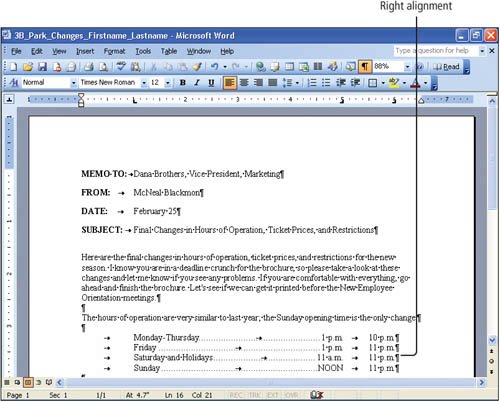
|
Another Way: To Create an Indent
Use an Indent to Start a Tabbed List
If the items in the first column of a list are indented the same amount using a left-aligned tab, you can save keystrokes by indenting the paragraph instead. You can do this by using the Increase Indent button on the Formatting toolbar, or by using the Paragraph dialog box. You can also drag the Left Indent marker from the left side of the ruler and position it at the desired location. When you are finished typing the list, you can drag the marker back to the left margin position. When you use an indent at the beginning of the paragraph for a tabbed list, you do not have to press the Tab key before you type the first item in the list.
Activity 3.12. Moving Tab Stops
If you are not satisfied with the arrangement of your text after setting tab stops, it is easy to reposition the text by moving tab stops.
|
1. |
In the four lines of tabbed text, disregard any wavy green lines or right-click them and click Ignore Once to remove them. Move the pointer into the left margin area, to the left of the first line of tabbed text. When the Figure 3.38. 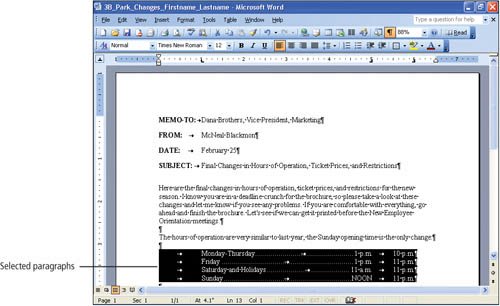
By selecting all of the paragraphs, changes you make to the tabs will be made to the tabs in all four rows simultaneously. |
|
2. |
With the four lines of tabbed text selected, point to the horizontal ruler and position the pointer so the tip of the pointer arrow is touching the 1-inch tab stop mark. When you see the ScreenTip Left Tab, drag the tab stop mark to the left to the 0.5-inch mark on the ruler, and then release the mouse button. Compare your screen with Figure 3.39. Figure 3.39. 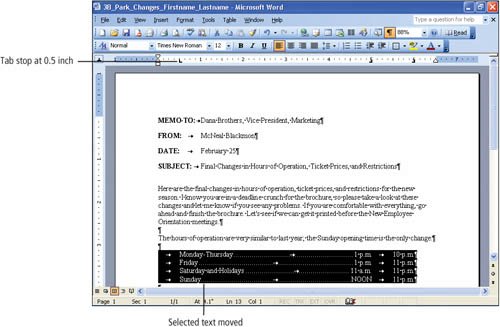
NoteSelecting Tab Stop Marks Selecting and moving tab stop marks on the horizontal ruler requires fairly exact mouse movement. The tip of the pointer must touch the tab mark. If you miss the mark by even a little, you will probably insert another tab stop. One way to tell if you are in the right position to move a tab stop on the ruler is to look for a ScreenTip showing the tab type. To remove an accidental tab stop when you are trying to select an existing one, click the Undo button and try again. Alternatively, you can drag the unwanted tab stop marker below the ruler and release the mouse button. |
|
3. |
In the horizontal ruler, point to the 5-inch tab stop until you see the ScreenTip Right Tab. Drag the tab stop mark to the left to the 4.5-inch mark on the horizontal ruler. Compare your screen with Figure 3.40. Figure 3.40. 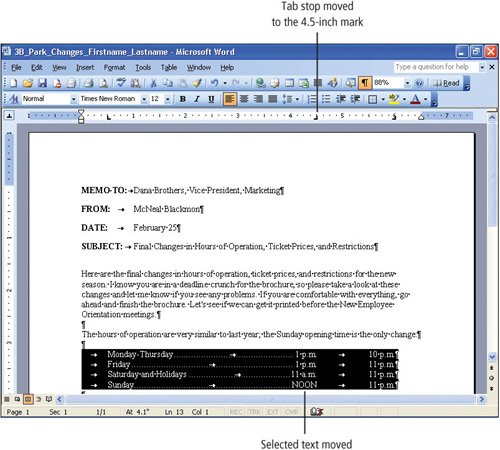
|
|
4. |
Click anywhere to deselect the text, and then Save |
Activity 3.13. Entering Text Using Click and Type
You can insert text or graphics anywhere on a page using the click and type pointer. This is accomplished by moving the pointer to the desired location and double-clicking.
|
1. |
From the Tools menu, click Options, and then click the Edit tab. Under Click and type, confirm that the Enable click and type check box is selectedif necessary, select it. Click OK to close the Options dialog box. |
|
2. |
Open the Footer area. On the Header and Footer toolbar, click the Insert AutoText button |
|
3. |
Move the pointer to the right of the file name in the footer, and then compare your screen with Figure 3.41. Figure 3.41. 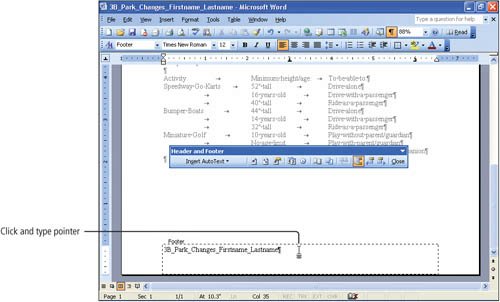
The pointer displays centered horizontal lines, unless your file name extends beyond the center of the footer, in which case left aligned horizontal lines display. The shape attached to the pointersmall centered linesindicates what type of formatting will be applied if you double-click at that location on the pagein this case a Center tab would be inserted. |
|
4. |
Move the pointer just inside the right edge of the footer area. When you see the Text Select pointer Figure 3.42. (This item is displayed on page 442 in the print version) 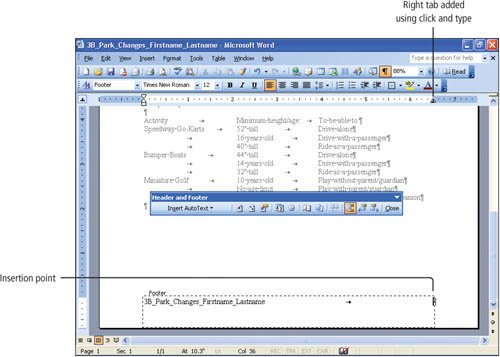
A right tab marker is placed in the ruler line at the Right Indent markera small mark at the right edge of the white area on the horizontal ruler. The Right Indent marker indicates the right margin of the paragraph containing the insertion point. |
|
|
|
|
5. |
Type Park Changes: DRAFT and then Close |
|
[Page 442 (continued)] Objective 4 Create a Table |
Windows XP
- Chapter One. Getting Started with Windows XP
- Project 1A. Windows XP
- Objective 1. Get Started with Windows XP
- Objective 2. Resize, Move, and Scroll Windows
- Objective 3. Maximize, Restore, Minimize, and Close a Window
- Objective 4. Create a New Folder
- Objective 5. Copy, Move, Rename, and Delete Files
- Objective 6. Find Files and Folders
- Objective 7. Compress Files
- Summary
- Key Terms
- Concepts Assessments
Outlook 2003
- Chapter One. Getting Started with Outlook 2003
- Getting Started with Microsoft Office Outlook 2003
- Project 1A. Exploring Outlook 2003
- Objective 1. Start and Navigate Outlook
- Objective 2. Read and Respond to E-mail
- Objective 3. Store Contact and Task Information
- Objective 4. Work with the Calendar
- Objective 5. Delete Outlook Information and Close Outlook
- Summary
- Key Terms
- Concepts Assessments
- Skill Assessments
- Performance Assessments
- Mastery Assessments
- Problem Solving
- GO! with Help
Internet Explorer
- Chapter One. Getting Started with Internet Explorer
- Getting Started with Internet Explorer 6.0
- Project 1A. College and Career Information
- Objective 1. Start Internet Explorer and Identify Screen Elements
- Objective 2. Navigate the Internet
- Objective 3. Create and Manage Favorites
- Objective 4. Search the Internet
- Objective 5. Save and Print Web Pages
- Summary
- Key Terms
- Concepts Assessments
- Skill Assessments
- Performance Assessments
- Mastery Assessments
- Problem Solving
Computer Concepts
- Chapter One. Basic Computer Concepts
- Objective 1. Define Computer and Identify the Four Basic Computing Functions
- Objective 2. Identify the Different Types of Computers
- Objective 3. Describe Hardware Devices and Their Uses
- Objective 4. Identify Types of Software and Their Uses
- Objective 5. Describe Networks and Define Network Terms
- Objective 6. Identify Safe Computing Practices
- Summary
- In this Chapter You Learned How to
- Key Terms
- Concepts Assessments
Word 2003
Chapter One. Creating Documents with Microsoft Word 2003
- Chapter One. Creating Documents with Microsoft Word 2003
- Getting Started with Microsoft Office Word 2003
- Project 1A. Thank You Letter
- Objective 1. Create and Save a New Document
- Objective 2. Edit Text
- Objective 3. Select, Delete, and Format Text
- Objective 4. Create Footers and Print Documents
- Project 1B. Party Themes
- Objective 5. Navigate the Word Window
- Objective 6. Add a Graphic to a Document
- Objective 7. Use the Spelling and Grammar Checker
- Objective 8. Preview and Print Documents, Close a Document, and Close Word
- Objective 9. Use the Microsoft Help System
- Summary
- Key Terms
- Concepts Assessments
- Skill Assessments
- Performance Assessments
- Mastery Assessments
- Problem Solving
- You and GO!
- Business Running Case
- GO! with Help
Chapter Two. Formatting and Organizing Text
- Formatting and Organizing Text
- Project 2A. Alaska Trip
- Objective 1. Change Document and Paragraph Layout
- Objective 2. Change and Reorganize Text
- Objective 3. Create and Modify Lists
- Project 2B. Research Paper
- Objective 4. Insert and Format Headers and Footers
- Objective 5. Insert Frequently Used Text
- Objective 6. Insert and Format References
- Summary
- Key Terms
- Concepts Assessments
- Skill Assessments
- Performance Assessments
- Mastery Assessments
- Problem Solving
- You and GO!
- Business Running Case
- GO! with Help
Chapter Three. Using Graphics and Tables
- Using Graphics and Tables
- Project 3A. Job Opportunities
- Objective 1. Insert and Modify Clip Art and Pictures
- Objective 2. Use the Drawing Toolbar
- Project 3B. Park Changes
- Objective 3. Set Tab Stops
- Objective 4. Create a Table
- Objective 5. Format a Table
- Objective 6. Create a Table from Existing Text
- Summary
- Key Terms
- Concepts Assessments
- Skill Assessments
- Performance Assessments
- Mastery Assessments
- Problem Solving
- You and GO!
- Business Running Case
- GO! with Help
Chapter Four. Using Special Document Formats, Columns, and Mail Merge
- Using Special Document Formats, Columns, and Mail Merge
- Project 4A. Garden Newsletter
- Objective 1. Create a Decorative Title
- Objective 2. Create Multicolumn Documents
- Objective 3. Add Special Paragraph Formatting
- Objective 4. Use Special Character Formats
- Project 4B. Water Matters
- Objective 5. Insert Hyperlinks
- Objective 6. Preview and Save a Document as a Web Page
- Project 4C. Recreation Ideas
- Objective 7. Locate Supporting Information
- Objective 8. Find Objects with the Select Browse Object Button
- Project 4D. Mailing Labels
- Objective 9. Create Labels Using the Mail Merge Wizard
- Summary
- Key Terms
- Concepts Assessments
- Skill Assessments
- Performance Assessments
- Mastery Assessments
- Problem Solving
- You and GO!
- Business Running Case
- GO! with Help
Excel 2003
Chapter One. Creating a Worksheet and Charting Data
- Creating a Worksheet and Charting Data
- Project 1A. Tableware
- Objective 1. Start Excel and Navigate a Workbook
- Objective 2. Select Parts of a Worksheet
- Objective 3. Enter and Edit Data in a Worksheet
- Objective 4. Construct a Formula and Use the Sum Function
- Objective 5. Format Data and Cells
- Objective 6. Chart Data
- Objective 7. Annotate a Chart
- Objective 8. Prepare a Worksheet for Printing
- Objective 9. Use the Excel Help System
- Project 1B. Gas Usage
- Objective 10. Open and Save an Existing Workbook
- Objective 11. Navigate and Rename Worksheets
- Objective 12. Enter Dates and Clear Formats
- Objective 13. Use a Summary Sheet
- Objective 14. Format Worksheets in a Workbook
- Summary
- Key Terms
- Concepts Assessments
- Skill Assessments
- Performance Assessments
- Mastery Assessments
- Problem Solving
- You and GO!
- Business Running Case
- GO! with Help
Chapter Two. Designing Effective Worksheets
- Designing Effective Worksheets
- Project 2A. Staff Schedule
- Objective 1. Use AutoFill to Fill a Pattern of Column and Row Titles
- Objective 2. Copy Text Using the Fill Handle
- Objective 3. Use AutoFormat
- Objective 4. View, Scroll, and Print Large Worksheets
- Project 2B. Inventory Value
- Objective 5. Design a Worksheet
- Objective 6. Copy Formulas
- Objective 7. Format Percents, Move Formulas, and Wrap Text
- Objective 8. Make Comparisons Using a Pie Chart
- Objective 9. Print a Chart on a Separate Worksheet
- Project 2C. Population Growth
- Objective 10. Design a Worksheet for What-If Analysis
- Objective 11. Perform What-If Analysis
- Objective 12. Compare Data with a Line Chart
- Summary
- Key Terms
- Concepts Assessments
- Skill Assessments
- Performance Assessments
- Mastery Assessments
- Problem Solving
- You and GO!
- Business Running Case
- GO! with Help
Chapter Three. Using Functions and Data Tables
- Using Functions and Data Tables
- Project 3A. Geography Lecture
- Objective 1. Use SUM, AVERAGE, MIN, and MAX Functions
- Objective 2. Use a Chart to Make Comparisons
- Project 3B. Lab Supervisors
- Objective 3. Use COUNTIF and IF Functions, and Apply Conditional Formatting
- Objective 4. Use a Date Function
- Project 3C. Loan Payment
- Objective 5. Use Financial Functions
- Objective 6. Use Goal Seek
- Objective 7. Create a Data Table
- Summary
- Key Terms
- Concepts Assessments
- Skill Assessments
- Performance Assessments
- Mastery Assessments
- Problem Solving
- You and GO!
- Business Running Case
- GO! with Help
Access 2003
Chapter One. Getting Started with Access Databases and Tables
- Getting Started with Access Databases and Tables
- Project 1A. Academic Departments
- Objective 1. Rename a Database
- Objective 2. Start Access, Open an Existing Database, and View Database Objects
- Project 1B. Fundraising
- Objective 3. Create a New Database
- Objective 4. Create a New Table
- Objective 5. Add Records to a Table
- Objective 6. Modify the Table Design
- Objective 7. Create Table Relationships
- Objective 8. Find and Edit Records in a Table
- Objective 9. Print a Table
- Objective 10. Close and Save a Database
- Objective 11. Use the Access Help System
- Summary
- Key Terms
- Concepts Assessments
- Skill Assessments
- Performance Assessments
- Mastery Assessments
- Problem Solving Assessments
- Problem Solving
- You and GO!
- Business Running Case
- GO! with Help
Chapter Two. Sort, Filter, and Query a Database
- Sort, Filter, and Query a Database
- Project 2A. Club Fundraiser
- Objective 1. Sort Records
- Objective 2. Filter Records
- Objective 3. Create a Select Query
- Objective 4. Open and Edit an Existing Query
- Objective 5. Sort Data in a Query
- Objective 6. Specify Text Criteria in a Query
- Objective 7. Print a Query
- Objective 8. Specify Numeric Criteria in a Query
- Objective 9. Use Compound Criteria
- Objective 10. Create a Query Based on More Than One Table
- Objective 11. Use Wildcards in a Query
- Objective 12. Use Calculated Fields in a Query
- Objective 13. Group Data and Calculate Statistics in a Query
- Summary
- Key Terms
- Concepts Assessments
- Skill Assessments
- Performance Assessments
- Mastery Assessments
- Problem Solving
- You and GO!
- Business Running Case
- GO! with Access Help
Chapter Three. Forms and Reports
- Forms and Reports
- Project 3A. Fundraiser
- Objective 1. Create an AutoForm
- Objective 2. Use a Form to Add and Delete Records
- Objective 3. Create a Form Using the Form Wizard
- Objective 4. Modify a Form
- Objective 5. Create an AutoReport
- Objective 6. Create a Report Using the Report Wizard
- Objective 7. Modify the Design of a Report
- Objective 8. Print a Report and Keep Data Together
- Summary
- Key Terms
- Concepts Assessments
- Skill Assessments
- Performance Assessments
- Mastery Assessments
- Problem Solving
- You and GO!
- Business Running Case
- GO! with Help
Powerpoint 2003
Chapter One. Getting Started with PowerPoint 2003
- Getting Started with PowerPoint 2003
- Project 1A. Expansion
- Objective 1. Start and Exit PowerPoint
- Objective 2. Edit a Presentation Using the Outline/Slides Pane
- Objective 3. Format and Edit a Presentation Using the Slide Pane
- Objective 4. View and Edit a Presentation in Slide Sorter View
- Objective 5. View a Slide Show
- Objective 6. Create Headers and Footers
- Objective 7. Print a Presentation
- Objective 8. Use PowerPoint Help
- Summary
- Key Terms
- Concepts Assessments
- Skill Assessments
- Performance Assessments
- Mastery Assessments
- Problem Solving
- You and GO!
- Business Running Case
- GO! with Help
Chapter Two. Creating a Presentation
- Creating a Presentation
- Project 2A. Teenagers
- Objective 1. Create a Presentation
- Objective 2. Modify Slides
- Project 2B. History
- Objective 3. Create a Presentation Using a Design Template
- Objective 4. Import Text from Word
- Objective 5. Move and Copy Text
- Summary
- Key Terms
- Concepts Assessments
- Skill Assessments
- Performance Assessments
- Mastery Assessments
- Problem Solving
- You and GO!
- Business Running Case
- GO! with Help
Chapter Three. Formatting a Presentation
- Project 3A. Emergency
- Objective 1. Format Slide Text
- Objective 2. Modify Placeholders
- Objective 3. Modify Slide Master Elements
- Objective 4. Insert Clip Art
- Project 3B. Volunteers
- Objective 5. Apply Bullets and Numbering
- Objective 6. Customize a Color Scheme
- Objective 7. Modify the Slide Background
- Objective 8. Apply an Animation Scheme
- Summary
- Key Terms
- Concepts Assessments
- Skill Assessments
- Performance Assessments
- Mastery Assessments
- Problem Solving
- You and GO!
- Business Running Case
- GO! with Help
Integrated Projects
Chapter One. Using Access Data with Other Office Applications
- Chapter One. Using Access Data with Other Office Applications
- Introduction
- Project 1A. Meeting Slides
- Objective 1. Export Access Data to Excel
- Objective 2. Create a Formula in Excel
- Objective 3. Create a Chart in Excel
- Objective 4. Copy Access Data into a Word Document
- Objective 5. Copy Excel Data into a Word Document
- Objective 6. Insert an Excel Chart into a PowerPoint Presentation
Chapter Two. Using Tables in Word and Excel
- Chapter Two. Using Tables in Word and Excel
- Introduction
- Project 2A. Meeting Notes
- Objective 1. Plan a Table in Word
- Objective 2. Enter Data and Format a Table in Word
- Objective 3. Create a Table in Word from Excel Data
- Objective 4. Create Excel Worksheet Data from a Word Table
Chapter Three. Using Excel as a Data Source in a Mail Merge
- Chapter Three. Using Excel as a Data Source in a Mail Merge
- Introduction
- Project 3A. Mailing Labels
- Objective 1. Prepare a Mail Merge Document as Mailing Labels
- Objective 2. Choose an Excel Worksheet as a Data Source
- Objective 3. Produce and Save Merged Mailing Labels
- Objective 4. Open a Saved Main Document for Mail Merge
Chapter Four. Linking Data in Office Documents
- Chapter Four. Linking Data in Office Documents
- Introduction
- Project 4A. Weekly Sales
- Objective 1. Insert and Link in Word an Excel Object
- Objective 2. Format an Object in Word
- Objective 3. Open a Word Document That Includes a Linked Object, and Update Links
Chapter Five. Creating Presentation Content from Office Documents
EAN: 2147483647
Pages: 448







 and set the Zoom
and set the Zoom  to Page Width.
to Page Width. two times. At the left end of the horizontal ruler, point to the Tab Alignment button
two times. At the left end of the horizontal ruler, point to the Tab Alignment button  your document.
your document. pointer displays, drag down to select the four lines of text as shown in Figure 3.38.
pointer displays, drag down to select the four lines of text as shown in Figure 3.38. , and then click Filename.
, and then click Filename. with several lines that are aligned right, double-click, and then compare your screen with Figure 3.42.
with several lines that are aligned right, double-click, and then compare your screen with Figure 3.42. the Footer area. Save
the Footer area. Save 